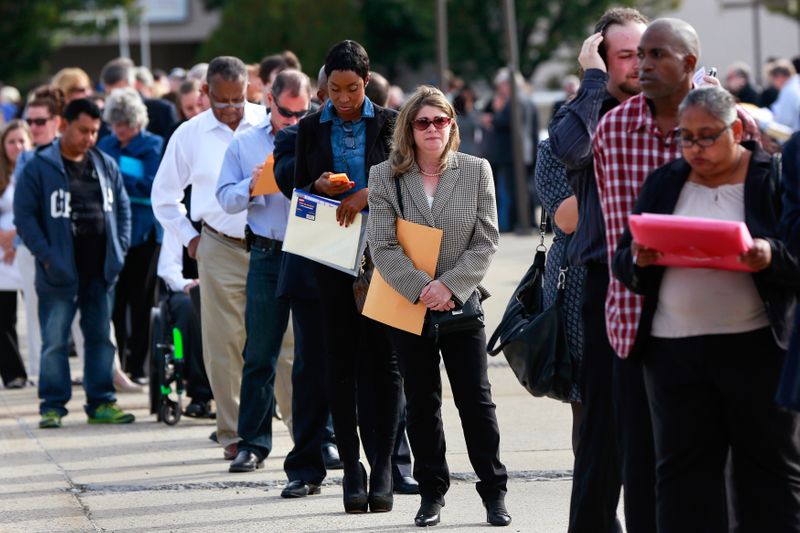WASHINGTON (Reuters) – U.S. layoffs eased in December and job openings increased modestly, suggesting the decline in employment that month was largely due to companies cutting back on hiring amid uncertainty caused by a raging COVID-19 pandemic.
Though the Labor Department’s monthly Job Openings and Labor Turnover Survey, or JOLTS report, offered cautious optimism that job growth could regain speed as coronavirus vaccines become accessible to large swaths of the population, unemployment remains pervasive.
The economy shed jobs in December for the first time in eight months following renewed outbreaks of the virus.
“The decline in employment in December was more a product of reduced hiring than a pick-up in layoffs,” said Nick Bunker, director of research at Indeed Hiring Lab. “Employers were hesitant about adding new workers. This trend is easier to reverse than the destruction of employer-employee relationships that happens when workers are laid off.”
Job openings, a measure of labor demand, rose 74,000 to 6.65 million on the last day of December from 6.572 million. There were an additional 296,000 job openings in the professional and business services industry. But vacancies decreased for state and local government, excluding education.
There also were fewer unfilled jobs in the arts, entertainment and recreation industries as well as at factories producing goods that are not intended to last longer than three years, such as clothing.
The job openings rate ticked up to 4.5% from 4.4% in November. Layoffs decreased by 243,000 to 1.81 million, lowering the layoffs rate to 1.3% from 1.4% in November. Layoffs declined in the federal government, transportation, warehousing and utilities industries as well as the healthcare and social assistance sector.
But 50,000 people were laid off in the arts, entertainment, and recreation industry.
Hiring dropped by 396,000 to 5.54 million. It was led by a decrease of 221,000 in the accommodation and food services industry. Hiring in the transportation, warehousing, and utilities sector fell by 133,000 and decreased by 82,000 in the arts, entertainment and recreation industry.
But retailers hired 94,000 workers. The hiring rate declined to 3.9% from 4.2% in November.
U.S. financial markets were unmoved by the data.
WORKER SHORTAGE
The government reported on Friday that the economy created only 49,000 jobs in January after shedding 227,000 jobs in December. Employment is 9.9 million jobs below its peak in February 2020.
The labor market has largely stalled amid a resurgence in COVID-19 infections, which now appears to be ebbing. In December, there were 16 unemployed people for every 10 job openings.
“The January jobs report was a stark reminder that near-term risks remain tilted to the downside amid a third COVID-19 wave,” said Lydia Boussour, lead U.S. economist at Oxford Economics in New York. “But the labor market outlook is slowly brightening. We foresee increased vaccinations, elevated savings and robust business activity contributing to a 6.6 million jobs rebound in 2021.”
Many economists do not expect the labor market to return to its pre-pandemic peak until 2023. Amid the labor market slack, signs of a skills mismatch are emerging.
A separate survey from the NFIB on Tuesday showed a third of small businesses reported in January that they had vacancies they could not fill, with 28% of those for skilled workers.
The dearth of skilled workers was more acute in construction, with 56% of firms reporting few or no qualified applicants, according to the NFIB. Overall, among small businesses hiring or trying to hire, 90% also reported few or no qualified applicants for the positions they were trying to fill.
“The pandemic has undoubtedly made it more difficult for many workers to rejoin the workforce, while the expansion of unemployment benefits has likely also reduced the urgency to return to work,” said Mark Vitner, a senior economist at Wells Fargo Securities in Charlotte, North Carolina.
The JOLTS report also showed the number of people voluntarily quitting their jobs rose 106,000 to 3.29 million in December. That lifted the quits rate to 2.3% from 2.2% in November. The quits rate is normally viewed by policymakers and economists as a measure of job market confidence.
But the pandemic has forced millions of women to drop out of the labor force mostly because of problems related to child care, with many schools still only offering online learning.
(Reporting by Lucia Mutikani; Editing by Paul Simao)

























